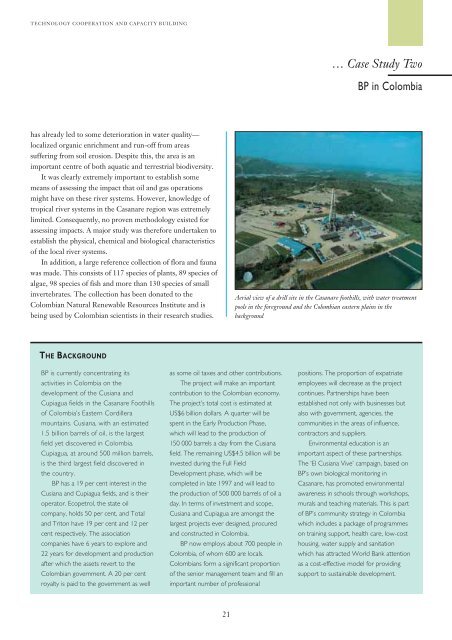Technology Cooperation and Capacity Building - CommDev
Technology Cooperation and Capacity Building - CommDev
Technology Cooperation and Capacity Building - CommDev
You also want an ePaper? Increase the reach of your titles
YUMPU automatically turns print PDFs into web optimized ePapers that Google loves.
TECHNOLOGY COOPERATION AND CAPACITY BUILDING… Case Study TwoBP in Colombiahas already led to some deterioration in water quality—localized organic enrichment <strong>and</strong> run-off from areassuffering from soil erosion. Despite this, the area is animportant centre of both aquatic <strong>and</strong> terrestrial biodiversity.It was clearly extremely important to establish somemeans of assessing the impact that oil <strong>and</strong> gas operationsmight have on these river systems. However, knowledge oftropical river systems in the Casanare region was extremelylimited. Consequently, no proven methodology existed forassessing impacts. A major study was therefore undertaken toestablish the physical, chemical <strong>and</strong> biological characteristicsof the local river systems.In addition, a large reference collection of flora <strong>and</strong> faunawas made. This consists of 117 species of plants, 89 species ofalgae, 98 species of fish <strong>and</strong> more than 130 species of smallinvertebrates. The collection has been donated to theColombian Natural Renewable Resources Institute <strong>and</strong> isbeing used by Colombian scientists in their research studies.Aerial view of a drill site in the Casanare foothills, with water treatmentpools in the foreground <strong>and</strong> the Colombian eastern plains in thebackgroundTHE BACKGROUNDBP is currently concentrating itsactivities in Colombia on thedevelopment of the Cusiana <strong>and</strong>Cupiagua fields in the Casanare Foothillsof Colombia’s Eastern Cordilleramountains. Cusiana, with an estimated1.5 billion barrels of oil, is the largestfield yet discovered in Colombia.Cupiagua, at around 500 million barrels,is the third largest field discovered inthe country.BP has a 19 per cent interest in theCusiana <strong>and</strong> Cupiagua fields, <strong>and</strong> is theiroperator. Ecopetrol, the state oilcompany, holds 50 per cent, <strong>and</strong> Total<strong>and</strong> Triton have 19 per cent <strong>and</strong> 12 percent respectively. The associationcompanies have 6 years to explore <strong>and</strong>22 years for development <strong>and</strong> productionafter which the assets revert to theColombian government. A 20 per centroyalty is paid to the government as wellas some oil taxes <strong>and</strong> other contributions.The project will make an importantcontribution to the Colombian economy.The project’s total cost is estimated atUS$6 billion dollars. A quarter will bespent in the Early Production Phase,which will lead to the production of150 000 barrels a day from the Cusianafield. The remaining US$4.5 billion will beinvested during the Full FieldDevelopment phase, which will becompleted in late 1997 <strong>and</strong> will lead tothe production of 500 000 barrels of oil aday. In terms of investment <strong>and</strong> scope,Cusiana <strong>and</strong> Cupiagua are amongst thelargest projects ever designed, procured<strong>and</strong> constructed in Colombia.BP now employs about 700 people inColombia, of whom 600 are locals.Colombians form a significant proportionof the senior management team <strong>and</strong> fill animportant number of professionalpositions. The proportion of expatriateemployees will decrease as the projectcontinues. Partnerships have beenestablished not only with businesses butalso with government, agencies, thecommunities in the areas of influence,contractors <strong>and</strong> suppliers.Environmental education is animportant aspect of these partnerships.The ‘El Cusiana Vive’ campaign, based onBP’s own biological monitoring inCasanare, has promoted environmentalawareness in schools through workshops,murals <strong>and</strong> teaching materials. This is partof BP’s community strategy in Colombiawhich includes a package of programmeson training support, health care, low-costhousing, water supply <strong>and</strong> sanitationwhich has attracted World Bank attentionas a cost-effective model for providingsupport to sustainable development.21















![[PDF] Community Development Toolkit - CommDev](https://img.yumpu.com/48616495/1/184x260/pdf-community-development-toolkit-commdev.jpg?quality=85)
